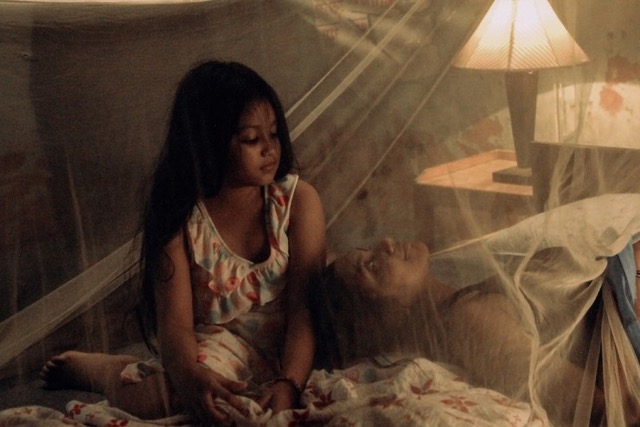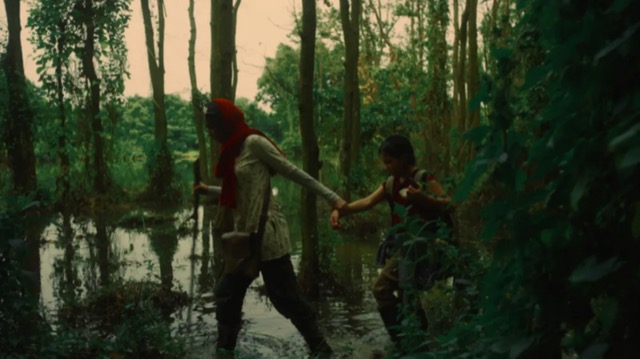Moshari opens with an expanding shot of mosquitos batting over a mass unseen in a foreboding opening of decay. We focus on a cow carcass, its horn a sharp, dangerous object. A young girl, Ayra (Naira Onora Saif) is praying – or is it an incantation? – over the cow while her older sister, Apu (Sunerah Binte Kamal) questions her motive. The young girl replies, “You’re an ass.” Immediately, we know these are two sisters who put survival first and sentiment last.
The girls take a rowboat through the wetlands of South Asia and trek through sludge and junk toward home. Ayra clutches the horn, cut loose offscreen, from the cow introducing larger spiritual and supernatural implications. In Hinduism, the cow is sacred as its symbol of life. Alternately, in many religions, mythology, and occultism, a horned deity is a subject of worship.

Back in this world, each golden hour reminding all to be back in their moshari by nightfall to avoid the fates of a fallen America and Europe. There’s an anti-imperialism message tucked into the announcement too: these rich countries shamed them for their poverty but South Asia holds the privilege now, even if their only wealth is life.
When the girls arrive home, Apu takes the horn out of the moshari, not wanting it in bed with her. She drops it by their door and busies herself with securing their protective net. They try to sleep, Apu on a few sleeping pills while Ayra strokes the netting until her finger lands on a small hole. She wriggles a finger through and provokes the air. After a stretch of quiet play, another finger – black and sharp nailed – appears and meets hers. Ayra looks away at Apu, fast asleep, but turns back to face the creature shaded by netting. The next moments gather quickly: Ayra is missing, a bloody sheet on the side of the bed.
The ending of this film is not what you’ll expect as both sisters run through a moral ringer. The film lands on an emotional note, wrapping maternal instinct and care into an otherwise lawless existence. Both actresses are visceral in their roles making revealing choices and expanding the scope of limited dialogue. Other than the on-the-nose period reference, the dialogue does solid work tugging out history, identity, and character. The dialogue and directorial choices do flirt with varying religious symbols, but leave the viewer to make their confident bet on what’s behind the blood sucking.

The bulk of the film is housed in and around the mosquito net – an exquisite visual and tension choice – but the other landscapes serve well too: a vast junkyard, a polluted pink sky over lush wetlands, and the hallway that’s unornamented other than shards of glass lining the ground.
The cinematography (Ejaz Mehedi) is alternatingly crisp and muddy, both choices appropriate. Close shots build tension while the brisk dialogue and fairly quick pacing keep viewers alert and anxious. There’s a slow, expanding shot of the moshari bed against a delightful, shrill score (Dameer Khan) that at its widest receives the title credits in a near full-screen red font; the sound and visual choices are reminiscent of classic horror films of the ‘80s like The Thing. This shot is followed by the definition for moshari, redundant with the dialogue already expressing the meaning.
Nuhash Humayun is a Bangladesh-based writer and director using his setting thoughtfully as it raises frightening questions and nods to broad social horror. Humayun is in full control of his fresh, genre-blended vision weaving horror and drama that can reach everyone. There’s a jump scare, a furry black fingernail wagging, a monster, and demonic elements – but the sister’s unusual rapport and the boundaries of this family are what truly terrifies.
Moshari takes us into the net of two women who are not heroic or trying to be; survival is as much a feat of the mind – as the body.

